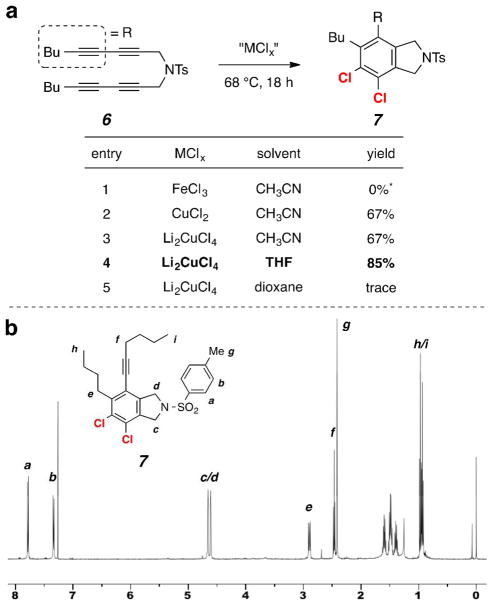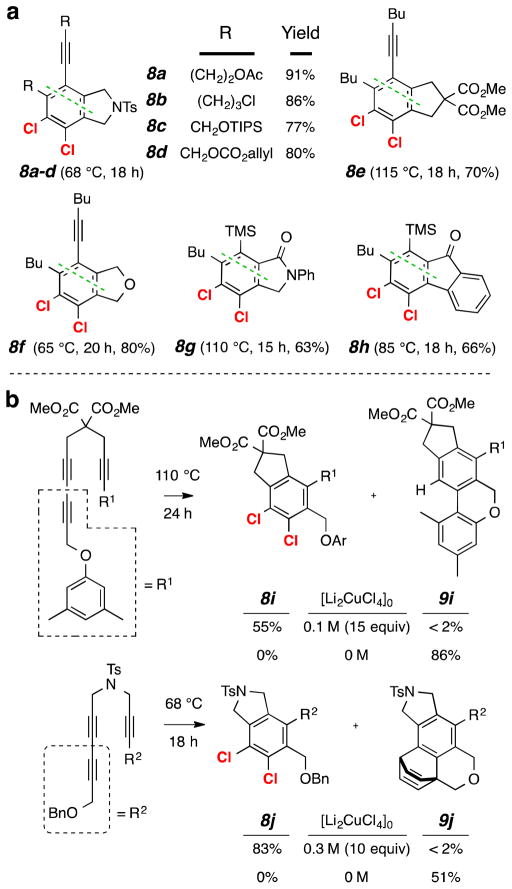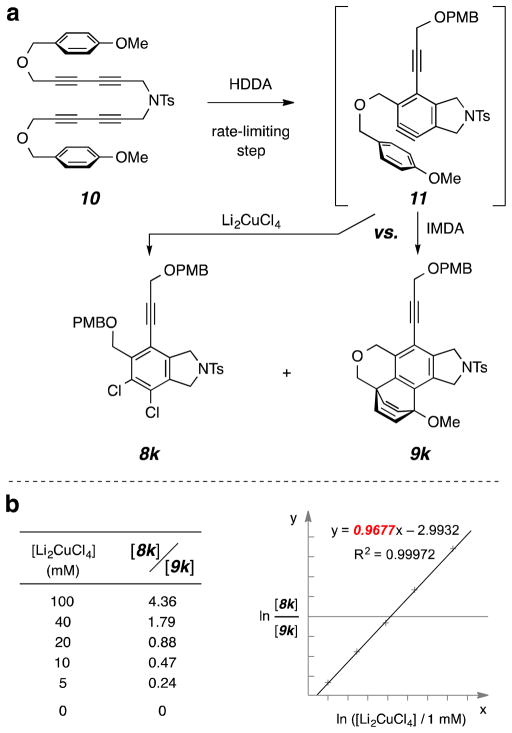Abstract
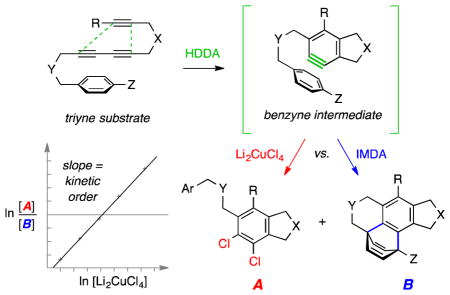
The efficient dichlorination of benzynes prepared by the hexadehydro-Diels–Alder (HDDA) reaction is reported. Cycloisomerization of a triyne substrate in the presence of dilithium tetrachlorocuprate is shown to provide dichlorinated products A by capture of the benzyne intermediate. A general strategy for discerning the kinetic order of an external aryne trapping agent is presented. It merely requires measurement of the competition between bimolecular vs. unimolecular trapping events (here, dichlorination vs. IMDA reaction to give A vs. B, respectively) as a function of the concentration of the trapping agent.
Arynes represent a very old and well-studied class of reactive intermediates in organic chemistry. Since the report over a century ago of what is now recognized as the first example of a transformation consistent with a benzyne species,1 many methods for aryne generation have been developed.2 Most commonly used is the strategy introduced by Kobayashi in 1983, in which ortho-TMSPhOTf (or a substituted variant) is treated with fluoride ion to generate the aryne under mildly basic conditions.3 This method, because of its operational ease and broad functional group compatibility, spurred renewed interest in aryne trapping chemistry.4 Last year, we reported the generality of a transformation we call the hexadehydro-Diels–Alder (HDDA) reaction. This thermal cycloisomerization of a triyne precursor (e.g., 1) constitutes a reagent- and byproduct-free method for making benzyne intermediates of considerable structural complexity (e.g., 2). This convenient conversion of a triyne substrate to aryne intermediate has enabled us and others to explore aspects of intrinsic aryne reactivity,5,6 including the discovery of entirely new modes of trapping reactions.5b,6a However, despite the numerous (and multifaceted) aryne trapping reactions that have been developed to date, rarely has it been possible to probe kinetic aspects of these powerful transformations. This is not a trivial problem because the benzyne forming reaction rather than its subsequent trapping is nearly always the rate-limiting event. Certainly there is no report of a general strategy for studying the kinetics of aryne trapping [e.g., for deducing the kinetic order of the trapping reactant(s)].
Aryl chlorides are commonly encountered in, for example, agrochemicals, pharmaceuticals, natural products, and photonic materials. Aryl chlorides have also grown in importance as synthetic intermediates in light of improved methodologies capable of activating the relatively inert Csp2-Cl bonds.7 Classically, aryl chlorides are made from the Sandmeyer reaction or electrophilic aromatic halogenation. One of the benzyne trapping reactions we have reported5a is that with an HBr source to produce the monobromoarenes 3a and 3b (Scheme 1). Since then, we have observed that treatment with various ammonium chlorides gives a similar outcome, namely the formation of monochlorides 4a and 4b.
Scheme 1a.
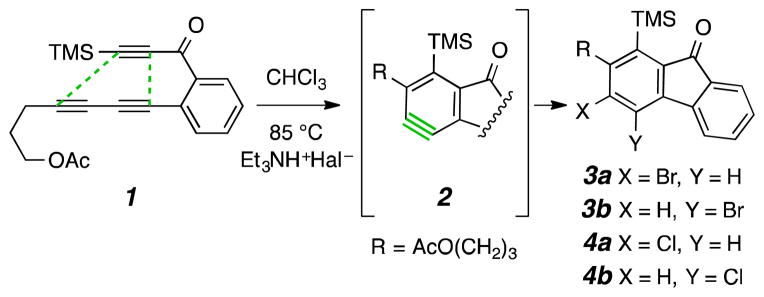
a Monohalo arene formation [3 or 4; 70–80% yield (3a:3b = 13:1; 4a:4b = 6:1)] through net hydrogen halide addition to the benzyne 2 formed via the HDDA reaction of the triyne 1..
1,2-Dichlorobenzene derivatives, the principal subject of the investigations reported here, are seen in target compounds of interest, as represented by the structures 5a–d (Figure 1). The preparation of ortho-dichlorinated arenes is more challenging than that of monochloroarenes. There are only a few reports of direct 1,2-dihalogenation of arynes. These are limited to (i) diiodination8,9 (with I2) or dibromination8a (with Br2), in which the reactions tend to proceed less effectively for arynes more elaborate than those of benzyne itself (from anthranilic acid or ortho-TMSPhOTf)8c and (ii) vicinal, mixed fluorohalogenation via silver(I)-promoted, net addition of FCl, FBr, or FI to HDDA-generated benzynes.6b We are not aware of any examples of aryne dichlorination. A strategy to make 1,2-dichlorinated arenes from triynes via the intermediate benzynes is reported here. It is additionally important that in the course of these studies, a simple but general protocol that can be used to gain insight to various kinetic aspects of aryne trapping events has also been developed.
Figure 1.
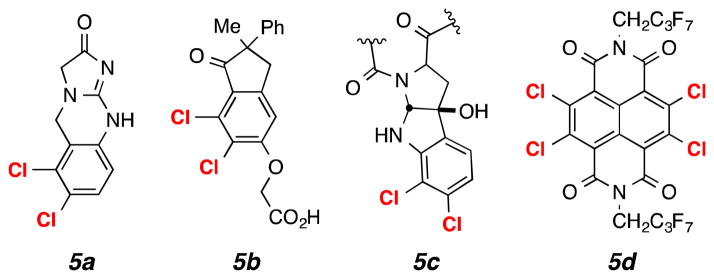
Examples of 1,2-dichlorinated target compounds (5a, Agrylin®, platelet reducing agent for treatment of thrombocytosis; 5b, indacrinone, diuretic developed for treatment of gout and hypertension; 5c, kutznerides, antimicrobial cyclic peptides; and 5d, for organoelectronic applications).
We initially explored the possibility of trapping the HDDA-generated benzyne 2 with either I2 or Br2. We were not surprised that this experiment did not produce observable amounts of the desired dihalobenzenes (i.e., 3/4 where X = Y = I or Br). In general, one practical feature of HDDA chemistry is that the alkynes in the triyne reactant need to be compatible with the agents intended to trap the intermediate benzynes under the conditions required to generate the benzyne. For example, addition of Cl2 (and Br2) to alkynes is relatively fast and is not expected to be compatible with most HDDA substrates. However, various metal halides are known to act as milder dihalogen surrogates for some dihalogen addition reactions.10 We have learned that dilithium tetrachlorocuprate (Li2CuCl4) functions as an effective dichlorinating agent of HDDA-generated benzynes and report those observations here.
We used the symmetrical tetrayne 6 for our initial explorations; it is both quite easy to prepare and has relatively high reactivity as a HDDA substrate. When a solution of 6 in CH3CN was heated in the presence of FeCl3, no desired dichlorination product 7 was formed, as judged by GC or TLC analysis (entry 1, Figure 2a). The first indication of a successful outcome was seen with the use of CuCl2 in acetonitrile. Addition of 6 and warming the resulting solution to 68 °C led to the formation of 7 in 67% yield following purification. Use of Li2CuCl4, formed in situ by mixing CuCl2 with solid LiCl, in acetonitrile gave the desired dichlorination product in a similar yield. The efficiency of the reaction was increased when the solvent was changed to THF; 7 was isolated in 85% yield. Under these conditions, no noticeable amount of dihydrogenation (by THF)5b or HCl addition products derived from competitive trapping of the intermediate benzyne was observed. Notably, dioxane was an ineffective solvent for this transformation, presumably due to the low solubility of Li2CuCl4, a feature that stands in contrast to its high solubility in THF.
Figure 2.
a. Identification of Li2CuCl4 as an effective reagent for dichlorination of the benzyne derived from tetrayne 6. b. 1H NMR spectrum of the crude product mixture following simple extractive workup of the entry 4 experiment.
We next probed some of the scope of this Li2CuCl4-mediated dichlorination reaction. Products 8a–h (Figure 3a) encompass dichlorinated isoindoline, isoindolone, isobenzofuran, indane, and fluorenone skeletons. These results show that a variety of functional groups are tolerated in the triyne precursors and/or the benzenoid products. They include toluenesulfonamide, ketone, ester, amide, carbonate, alkyl or aryl chloride, silyl ether, silyl alkyne, alkene, and (electron rich) aromatic ring. However, we have observed that triyne substrates containing a free alcohol or terminal alkyne are not compatible with the reaction conditions.
Figure 3.
a. Products (8a–h) of dichlorination (10 equiv of Li2CuCl4, [substrate]0 = 0.03 M in THF) of various HDDAderived arynes. The green dashed line indicates the C–C bonds formed in the HDDA reaction. b. Competitive dichlorination (to 8i or 8j) vs. intramolecular benzyne trapping by aromatic ene (to 9i)5c or Diels-Alder (to 9j)5a reactions, respectively.
Notably, each of the benzyne precursors to 8i and 8j bears an intramolecular trap. In the absence of an external trapping agent, efficient aromatic Diels-Alder5a or aromatic ene5c reaction within the intermediate benzyne occurs to give 9i or 9j, respectively (Figure 3b). However, in the presence of Li2CuCl4 these intramolecular trapping modes were largely if not completely superseded by chlorination to instead produce 8i or 8j.
In the course of sorting out some of the details of these competition reactions, we noticed that for the case of products 8k vs. 9k, the extent of formation of the latter could not be entirely suppressed (Figure 4). Moreover, the amount of 9k formed was dependent on the concentration of the Li2CuCl4 used in any given experiment. This led us to consider in further detail the factors that are relevant to this pair of competing events. The Diels–Alder adduct 9k results from unimolecular cycloaddition within the benzyne 11.11 On the other hand, reaction between 11 and the chlorination agent is intermolecular and the rate of that trapping event should be, therefore, dependent on the concentration Li2CuCl4. The ratio of rate equations for the formation of 8k and 9k can be expressed as shown in eq 1 which, rewritten, is eq 2. When Li2CuCl4 is present in excess, eq 2 can be approximated by eq 3, which can also be expressed as eq 4.
Figure 4.
a. Competition experiment involving the intramolecular Diels-Alder (IMDA) reaction of benzyne 11 vs. the bimolecular trapping by Li2CuCl4 to give 9k vs. 8k. b. Product ratios at varying concentrations of Li2CuCl4 (20 equiv in each case) and the log-log plot from which the kinetic order was obtained.
| (eq 1) |
| (eq 2) |
| (eq 3) |
| (eq 4) |
The product ratio of 8k to 9k was measured at a series of different concentrations of Li2CuCl4 and the results are given in Figure 4 (panel b). The slope of the plot of ln[8k]/[9k] vs. ln[Li2CuCl4] shows that formation of 8k has a first-order dependence on [Li2CuCl4], indicating that only one copper species is involved up through the rate-limiting step in the product-forming phase of the reaction.
In conclusion, we have developed a new and efficient benzyne dichlorination reaction using the mild oxidizing agent, dilithium tetrachlorocuprate. We have shown that various types of 1,2-dichlorinated products can be accessed. The conditions are compatible with a considerable variety of functional groups in the benzyne precursor and resultant benzenoid product. In the course of the studies, we have also developed a strategy for probing some important kinetic aspects of benzyne trapping reactions. In particular, we made use of the competitive intramolecular Diels–Alder (IMDA) reaction of benzyne 11 as an internal clock reaction and observed the change in ratio of the dichlorination to IMDA products as a function of the concentration of the dichlorinating agent. Thereby, we have shown that the dichlorination of benzyne 11 has a first order dependence on the concentration of Li2CuCl4. This protocol is noteworthy because kinetic studies of the reactions of arynes are challenging, given that the formation, not the trapping, of these highly reactive intermediates is virtually always the rate limiting event. This protocol— determining the change in product ratios arising from a bimolecular vs. an intramolecular trapping reaction as a function of concentration of the trapping agent— represents an approach we believe applicable for studying the molecularity of many other classes of intermolecular aryne trapping reactions. Such studies are in progress.
Supplementary Material
Acknowledgments
This investigation was supported by a grant awarded by the U.S. Department of Health and Human Services (National Institute of General Medical Sciences, GM-65597).
Footnotes
Supporting Information Available. Experimental procedures, characterization data, and copies of 1H- and 13C NMR spectra for all isolated compounds (81 pages).
References
- 1.Stoermer R, Kahlert B. Ber Dtsch Chem Ges. 1902;35:1633–1640. [Google Scholar]
- 2.Kitamura T. Aust J Chem. 2010;63:987–1001. [Google Scholar]
- 3.Himeshima Y, Sonoda T, Kobayashi H. Chem Lett. 1983;12:1211–1214. [Google Scholar]
- 4.Baire B, Niu D, Willoughby PH, Woods BP, Hoye TR. Nature Protocols. 2013;8:501–508. doi: 10.1038/nprot.2013.017. and earlier reviews cited therein. [DOI] [PMC free article] [PubMed] [Google Scholar]
- 5.a) Hoye TR, Baire B, Niu D, Willoughby PH, Woods BP. Nature. 2012;490:208–212. doi: 10.1038/nature11518. [DOI] [PMC free article] [PubMed] [Google Scholar]; b) Niu D, Willoughby PH, Baire B, Woods BP, Hoye TR. Nature. 2013;501:531–534. doi: 10.1038/nature12492. [DOI] [PMC free article] [PubMed] [Google Scholar]; c) Niu D, Hoye TR. [accessed Dec 4, 2013];Nature Chem. doi: 10.1038/nchem.1797. [Online early access] Published Online: Nov 17, 2013. http://www.nature.com/nchem/journal/vaop/ncurrent/full/nchem.1797.html. [DOI]
- 6.a) Yun SY, Wang KP, Lee NK, Mamidipalli P, Lee D. J Am Chem Soc. 2013;135:4668–4671. doi: 10.1021/ja400477r. [DOI] [PubMed] [Google Scholar]; b) Wang KP, Yun SY, Mamidipalli P, Lee D. Chem Sci. 2013;4:3205–3211. [Google Scholar]; c) Karmakar R, Mamidipalli P, Yun SY, Lee D. Org Lett. 2013;15:1938–1941. doi: 10.1021/ol4005905. [DOI] [PubMed] [Google Scholar]
- 7.Noyori S, Nishihara Y. Applied Cross-Coupling Reactions. Springer; Berlin Heidelberg: 2013. Recent Advances in Cross-Coupling Reactions with Aryl Chlorides, Tosylates, and Mesylates; pp. 177–202. [Google Scholar]
- 8.a) Friedman L, Logullo FM. Angew Chem, Int Ed. 1965;4:239–240. [Google Scholar]; b) Birkett MA, Knight DW, Little PB, Mitchell MB. Tetrahedron. 2000;56:1013. [Google Scholar]; c) Perry RJ, Turner SR. J Org Chem. 1991;56:6573. [Google Scholar]; d) Rodríguez-Lojo D, Cobas A, Peña D, Pérez D, Guitián E. Org Lett. 2012;14:1363–1365. doi: 10.1021/ol300439r. [DOI] [PubMed] [Google Scholar]
- 9.Buchwald SL, Lucas EA, Davis WM. J Am Chem Soc. 1989;111:397. [Google Scholar]
- 10.Rodebaugh R, Debenham JS, Fraser-Reid B, Snyder JP. J Org Chem. 1999;64:1758–1761. doi: 10.1021/jo9718509.Uemura S, Sasaki O, Okano M. J Chem Soc D. 1971:1064–1065.Uemura S, Onoe A, Okano M. Bull Chem Soc Jap P. 1974;47:692–697.See also, Kovacic P, Brace NO. J Am Chem Soc. 1954;76:5491–5494.Yang L, Lu Z, Stahl SS. Chem Commun. 2009:6460–6462. doi: 10.1039/b915487f.
- 11.We presume that the presence of Li2CuCl4 does not affect the rate of formation of 9k. If this reagent were acting to catalyze (or inhibit) the net Diels–Alder cycloaddition, then it would be highly improbable that the order of the dependence of formation of dichloride product 8k would be so close to a whole integer value.
Associated Data
This section collects any data citations, data availability statements, or supplementary materials included in this article.



